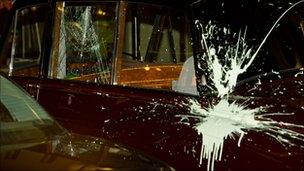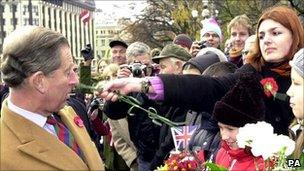Royal Wedding: Keeping the Royal Family safe but seen
- Published
- comments
.jpg)
Charles and Diana's 'undercover' policemen dressed in breeches to look the part as footmen
With thousands of visitors expected to flock to London for the wedding of Prince William and Kate Middleton, security is one of the event organisers' biggest priorities. But how can the Royal Family remain accessible to the public while also staying safe?
Back in 1981, the phrase "undercover officer" took on a new meaning during the wedding of Prince William's parents.
As Princess Diana, Prince Charles and other royals travelled across London in horse-drawn carriages, two of the footmen accompanying them were police sergeants. They had guns hidden in their breeches.
The policemen in tights and tunics were there because, just a month earlier, 17-year-old Marcus Serjeant had fired six blank shots at the Queen as she rode past the crowd on horseback during the annual Trooping the Colour. He was jailed under the 1842 Treason Act. "I wanted to be famous," he said later. "I wanted to be somebody."
His desire to be infamous led to the policemen being disguised as footmen.
The Metropolitan Police commissioner at the time, Sir David McNee, said afterwards that the arrangement was "not so much to add to an already weighty security apparatus," but rather "to provide the Royal Family with a feeling of comfort."
On Prince William and Kate Middleton's wedding day such "comfort" will be very visible. There will be police officers wherever you look.
Potential threats
Such an operation will be costly. The bill to the taxpayer for protecting the royals is never disclosed. The only figure in the public domain is the annual cost of £128m for providing protection to the royals, senior politicians, VIPs and diplomats.
The potential threat on 29 April is at least two-fold - terrorism and demonstrators using violence as they seek a global audience for their cause.
The police will be keen to ensure there is no repeat of the unrest which broke out alongside last weekend's peaceful TUC organised anti-cuts demonstration.
Senior officers have hinted they may use "stop and search" powers (under the Terrorism Act) on the streets around Buckingham Palace and Westminster Abbey, even without any suspicion that an actual offence had been committed.
For those in charge of royal security, it would probably be so much easier if this was America. There, the "principals" - as they're known in the jargon - are surrounded by a much more visible and intrusive security presence.
When, in 1998, President Clinton visited Omagh to offer his condolences to the victims of the Real IRA bomb, secret service agents all but took over the town in the hours before the president arrived.
During Prince Charles and the Duchess of Cornwall's tour of the US, after their wedding in 2005, I and other members of the British media had our very own agent. He came complete with trench coat, earpiece and shades. It was November. He followed us from one "sterile" area to another.
A dedicated bodyguard for royal correspondents is unlikely to catch on here.

The royal couple's Rolls-Royce, now fully repaired, will take Kate Middleton to Westminster Abbey
There's a constant tension between the need to protect and the desire of the Windsors to be seen and to be accessible. This would have been evident last year when Charles and Camilla's car was attacked during the student protests.
Though the precise details of what happened are shrouded in secrecy, it is likely the prince's police bodyguards would have wanted to either abandon the visit to the Royal Variety performance, or use a less high-profile car than the chosen, conspicuous Rolls Royce. The prince may well have argued, as he often does, that the "show must go on".
During the journey, the wife of the future king was poked with a stick through an open window. The heir to the throne likes to travel in well-ventilated vehicles.
Surreal
This wasn't a one-off. There have been numerous breaches of royal security down the years. None has resulted in any fatalities. Some have had a slightly surreal air.
The Prince of Wales was slapped across the face with a flower in Latvia and had two blank shots fired at him in Australia; his mother once woke up to discover an intruder, Michael Fagan was sitting at the end of her bed in Buckingham Palace; and Princess Anne was subjected to an unsuccessful kidnap attempt on the Mall by a man who was mentally ill.

A flower in the face may not be serious but for royal security it's no laughing matter
In 2003, a comedian, Aaron Barshak - dressed as a female Osama Bin Laden in a peach ball gown - gate-crashed Prince William's 21st birthday party and kissed him on both cheeks. William, at first, thought it was all part of the entertainment.
Those responsible for royal security don't, understandably, view such incidents as entertaining. They know they could all have ended very differently.
Their plans for the wedding day will be well advanced. There will be a visible police presence and a not-so-visible one. When it comes to policemen donning breeches, 30 years on from William's parents' wedding, history will probably repeat itself.